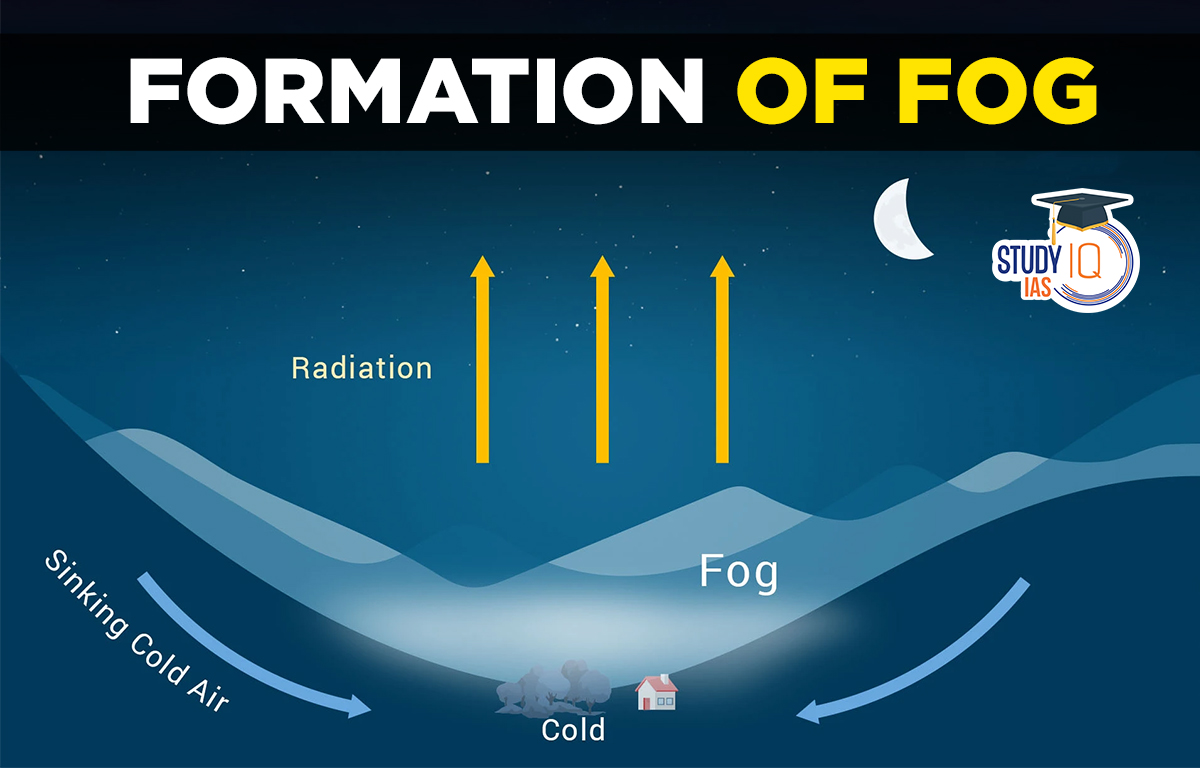Table of Contents
Context: Dense Formation of Fog has enveloped north-western India, including Delhi, Punjab, Haryana, parts of Uttar Pradesh, and parts of Rajasthan.
About Formation of Fog
- Fog is a cloud that touches the ground. It can be thin or thick.
- Formation of fog: Fog forms when water vapour condenses.
- The presence of moisture and a fall in the temperature are key factors for the formation of fog.
- With the land surface cooling down at night, the air close to the surface also cools down.
- Since cooler air cannot hold as much moisture as warm air, the water vapour in the air condenses to form fog.
- Conditions: Fog begins to form in the early hours of the morning, when the temperature is at its lowest.
- Spatial variability of Fog: Areas near water bodies, for instance, may see denser fog because of the higher humidity.

Types of Fog
- Radiation Fog: It forms in the evening when heat absorbed by the Earth’s surface during the day is radiated into the air.
- As heat is transferred from the ground to the air, water droplets form.
- Fog that is said to “burn off” in the morning sun is radiation fog.
- According to SAFAR forecasting system, fog episode in Delhi is categorised as “radiation fog”.
- Advection Fog: It forms when warm, moist air passes over a cool surface.
- When the moist, warm air makes contact with the cooler surface air, water vapor condenses to create fog.
- Advection fog shows up mostly in places where warm, tropical air meets cooler ocean water.
- Valley Fog: It forms in mountain valleys, usually during winter.
- It develops when mountains prevent the dense air from escaping. The fog is trapped in the bowl of the valley.
- Freezing Fog: It happens when the liquid fog droplets freeze to solid surfaces.
- Mountain tops that are covered by clouds are often covered in freezing fog.
- As the freezing fog lifts, the ground, the trees, and even objects like spider webs, are blanketed by a layer of frost.

Fog Episode in North-Western India
- Prevalence of Cold Wave: Cold wave conditions, in which the minimum temperature is significantly lower than normal, have been recorded recently over Punjab, Haryana, and parts of Rajasthan.
- Western Disturbances (WD): It can result in increased moisture levels over the region.
- WD’s are the storms that originate in the Mediterranean Sea and bring moisture-bearing winds to northwest India.
- However, WD’s has not yet brought much moisture and did not lead to any significant fog formation until December 19.
- Other Sources: Local moisture sources like water vapour from rivers and soil moisture can also cause fog.
- Pollution levels and Fog: Delhi being more polluted, records more fog days compared to others.
- As temperature declines, local wind speed falls. The inversion layer comes down and vertical mixing reduces.
- This result in fog formation and particulate matter hangs on the boundary layer, increasing pollution levels.
- Once the temperature increases during the day, the fog dissipates.
IMD Categorisation of Fog
- Fog is categorised as very dense when visibility is between 0 to 50 metres.
- Visibility between 51 and 200 metres identifies fog as dense.
- Moderate fog is identified with a visibility of 201 to 500.
- Whereas, 501 metres to 1,000 metres of visibility is present in shallow fog conditions and 1,000 shallow.
Delhi Fog Characteristics
- According to the India Meteorological Department (IMD), fall in temperature along with moisture and light winds over the Indo Gangetic Plain has resulted in dense fog over the region.
- Indo Gangetic Plain is most vulnerable to fog occurrences, with major, weeks-long spells of dense fog in the months of December and January.
- These foggy spells are linked to wind and temperature patterns.
- Its intensity can depend on factors like humidity, wind, and temperature,
- Variability: According to IMD, fog episodes over Delhi are highly variable.
- It shows very high variability with extreme fog of 25 to 35 days (200 to 285 hours) of dense fog” like in 2017-18. While, on the other hand, in December 2021 — Delhi hardly sees any dense fog events.
- Intensity: Highest number of dense fog (when visibility is less than 200 m) and very dense fog (visibility less than 50 m) days are usually seen in January in Delhi.
- Going by a 31-year average till 2021, Delhi records around 25.3 hours of “very dense” fog in December, and 38.3 such hours in January.


 National Technology Readiness Assessment...
National Technology Readiness Assessment...
 Justice Mission-2025: China’s Live-Fir...
Justice Mission-2025: China’s Live-Fir...
 Suryastra: First Made-in-India Long-Rang...
Suryastra: First Made-in-India Long-Rang...

























